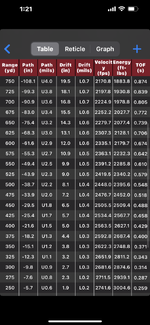I don't have much time for this tip, but I've answered some questions in other threads about long range shooting.
The bottom line is that long range shooting can be easy. One problem is that not everyone means the same thing with "long range" and not everyone is shooting with the same Ballistic Coefficient, Muzzle Velocity, and Bullet Weight.
All of those things matter to long range.
Here are some rules of thumb I use to break down how "easy" it is to shoot. I will use my 7 Sherman Short as my sample, running a 180 Berger VLD at 3050 fps MV.
What is the maximum point blank range for your rifle? My 7mm is 250 yards
This is why anything double your MPBR requires experience knowledge, and skill using my 7mm data at 800 yards:
The bottom line is that long range shooting can be easy. One problem is that not everyone means the same thing with "long range" and not everyone is shooting with the same Ballistic Coefficient, Muzzle Velocity, and Bullet Weight.
All of those things matter to long range.
Here are some rules of thumb I use to break down how "easy" it is to shoot. I will use my 7 Sherman Short as my sample, running a 180 Berger VLD at 3050 fps MV.
What is the maximum point blank range for your rifle? My 7mm is 250 yards
With my 7mm velocity, if I dial up .3 mil, which is 2.5 inches high at 100 and 2.5 inches low at 250 yards. A full value 10 mph crosswind is about 2.5 inches. BC of the bullet matters little inside the MPBR.
Everyone should be able to make this shot. There are no environmental conditions that would cause you to miss this shot, wind doesn't matter. Hold crosshair on the animal and fire. Your velocity matters. There is a massive difference between the point blank "range" a 30-30 and one of @Ryan Avery UM cartridges for point blank shooting.
Double the maximum point blank range of your rifle. My 7mm MPR doubled is 500 yards. I don't think that getting a dope card or CDS turret is enough to otherwise shoot beyond MPBR. There are too many things that a novice or slightly experienced long range shooter doesn't know without field experience encountering the variables that simply don't exist at a range. It isn't as easy as ranging and twisting a couple knobs. But, a little training and practice can get you there.Rangefinding is not always easy to avoid ranging in front or behind the animal. Inside 500 yards, my 7mm drops less than 5 inches every 25 yards. This allows for you to be off by about 10 feet at 500 yards, and the error is only 2.5 inches. If you are off by 25 yards at 500, you are now hitting 5 inches low or high depending whether you ranged too close or too far.
Wind is hard to read. You have to not only judge the wind speed, but also the angle, and then calculate the effect. A 7 mph wind drifts about 8 inches at 500 yards. If I call it a 7 mph wind, but it is really 3.5 mph or 10.5 mph, then the wind drift is off by 4 inches on either side of the point of aim. That is barely inside the kill zone of an antelope or coues deer.
Besides distance, other factors affect the drop to the effect of a few inches depending on all factors like:
- aerodynamic jump
- extreme spread in velocity
- difference in velocity because of ammo temp at range temperatures vs. winter mountain temp
- differences in actual temp/pressure vs. the dope card or input into the ballistic calculator
This is why I say double, because a rifleman with reasonable skills and enough long range experience and training can have high confidence of success with the small adjustments that need to be recognized and accounted for.
Beyond double MPBR requires a mixture of long range experience and learning, that give you sufficient knowledge of and exposure to all the many factors necessary to have high confidence in the shot. Training is often critical to get the knowledge, because you are gaining the knowledge of the millions of rounds that others have fired. Weigh the cost of training against the cost of time and money to get the hard wins through many miserable failures until you learn what others learned. Training is invaluable.This is why anything double your MPBR requires experience knowledge, and skill using my 7mm data at 800 yards:
- a "1 moa" gun starts with a group in 8 inches (and a three shot group in .25 moa off a bench is not where you start)
- a field position with added "wobble" of just .25 moa is 2 inches.
- a field position with reduced recoil control can easily add 1 moa or more to error, usually "up" so shots are over the back.
- a ranging error of 25 feet is about 10 inches.
- wind call error of 3.5 mph is about 10 inches.
- there can be multiple wind directions over 800 yards, which requires experience to even guess.
- terrain features can create wind shears and compression that will affect horizontal and vertical movement.
- a shot across a canyon can be subject to much higher wind speeds and directions that you can't feel from the shooting position.
- typical factory ammo extreme spread of velocity can vary drop by 5 inches or more.
- a little bit of moisture in the chamber can increase pressure and velocity.

